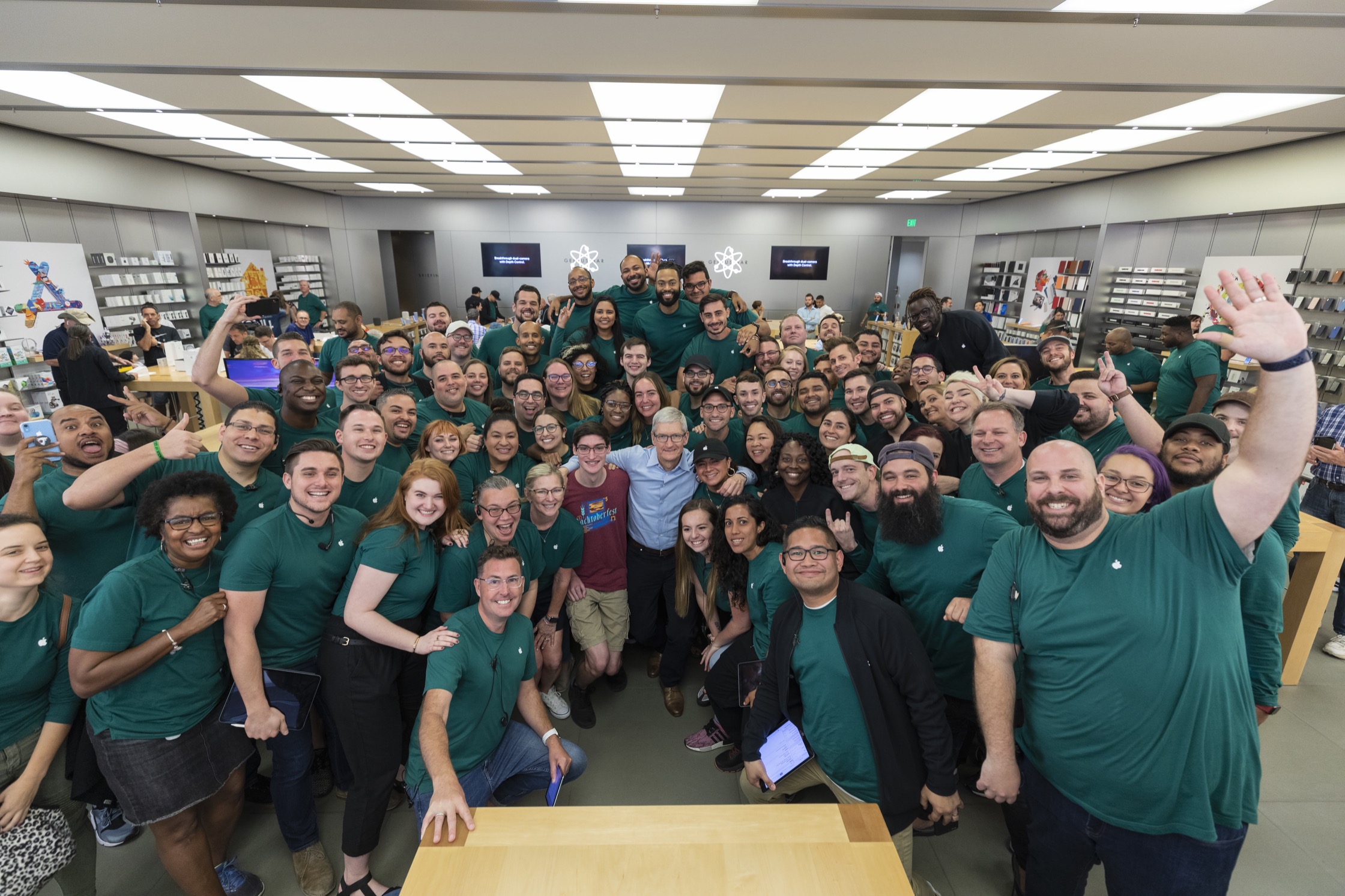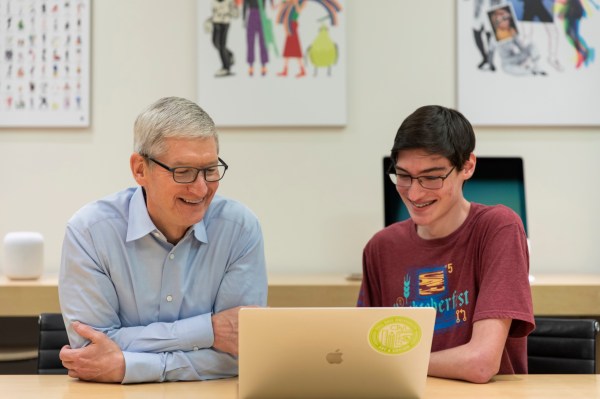For the past few years, Apple has been inviting student developers to attend its WWDC conference, which centers on development topics and software. A few students from this year’s batch are getting some more personal attention from Apple as it tries to raise awareness of the program and coding literacy via its Swift Playgrounds and other resources for students and teachers.
Most of those students, though, won’t get a surprise personal visit from CEO Tim Cook, which is what happened this week when Lyman High School student Liam Rosenfeld got to the Millenia Mall Apple Store in Orlando, Fla. Liam was there to participate, he thought, in an interview with myself and a local journalist from the Orlando Sentinel about his admission to the program.
As a surprise, and fresh off an appearance at the SAP Sapphire conference to announce an expanded partnership, Cook came to visit the store to greet employees, and to spend some time with Liam and his teacher, Mary Acken.
I was on hand to spend some time of my own with Liam, to talk to him about his experiences coding in high school and shipping on a global App Store. I also spoke to Cook about coding literacy, the SAP partnership and some other interesting topics.
The confab was set for Wednesday afternoon, with the store making an ideal meeting place, given its rough proximity to the conference and airport. Liam arrived earlier than expected and some interference had to be ran so that Cook’s appearance and the surprise, could be kept secret.
Code + music
Liam is a 10th grader at Lyman and will be continuing his computer science studies next year. Before then, however, he’ll be attending WWDC as a student scholarship winner. Apple’s continuing effort to make sure that Swift and the App Store remain as viable an on-ramp to young developers as possible are likely why Cook’s SAP outing included this meetup as well.
Liam and Cook slip into the store’s briefing room (many branches, especially remodeled ones, have these for corporate clients and other events). They spend some time chatting, Liam breaks out Xcode and walks Cook through the ins-and-outs of Image to ASCII Art, his first app on the App Store.
The app, he explains, converts an image to greyscale, calculates the number of characters and stroke thickness needed and replicates the image with characters. It’s gratifying, in a way, to realize that ASCII art remains a rite of passage for young people obsessed with computing.
Liam’s efforts don’t stop at his own apps, either. He’s also started a Coding Club at his school, with the help of Acken. There are 16 kids in the club, half boys and half girls, and they have won some coding competitions.
Cook asks Liam to walk him through his next app, called Note Ninja, that combines coding and music by leading people through a game that asks them to pick whether a note is sharp or flat.
I also ask Liam about his love of music and code, given that his second app is focused on music.
“They both can be anywhere from very analytical to very kind of straightforward,” he says, “but they’re both at their best when you combine the analytical side and the straightforward side.”
Cook leans into this comparison when I ask about Liam’s sophomore app.
“That’s my heart zone. He’s standing at that intersection that, all too often, is a lonely intersection. He is doing that in his way at this point of time in his life. He’s only 15 years old. It’s pretty impressive.”
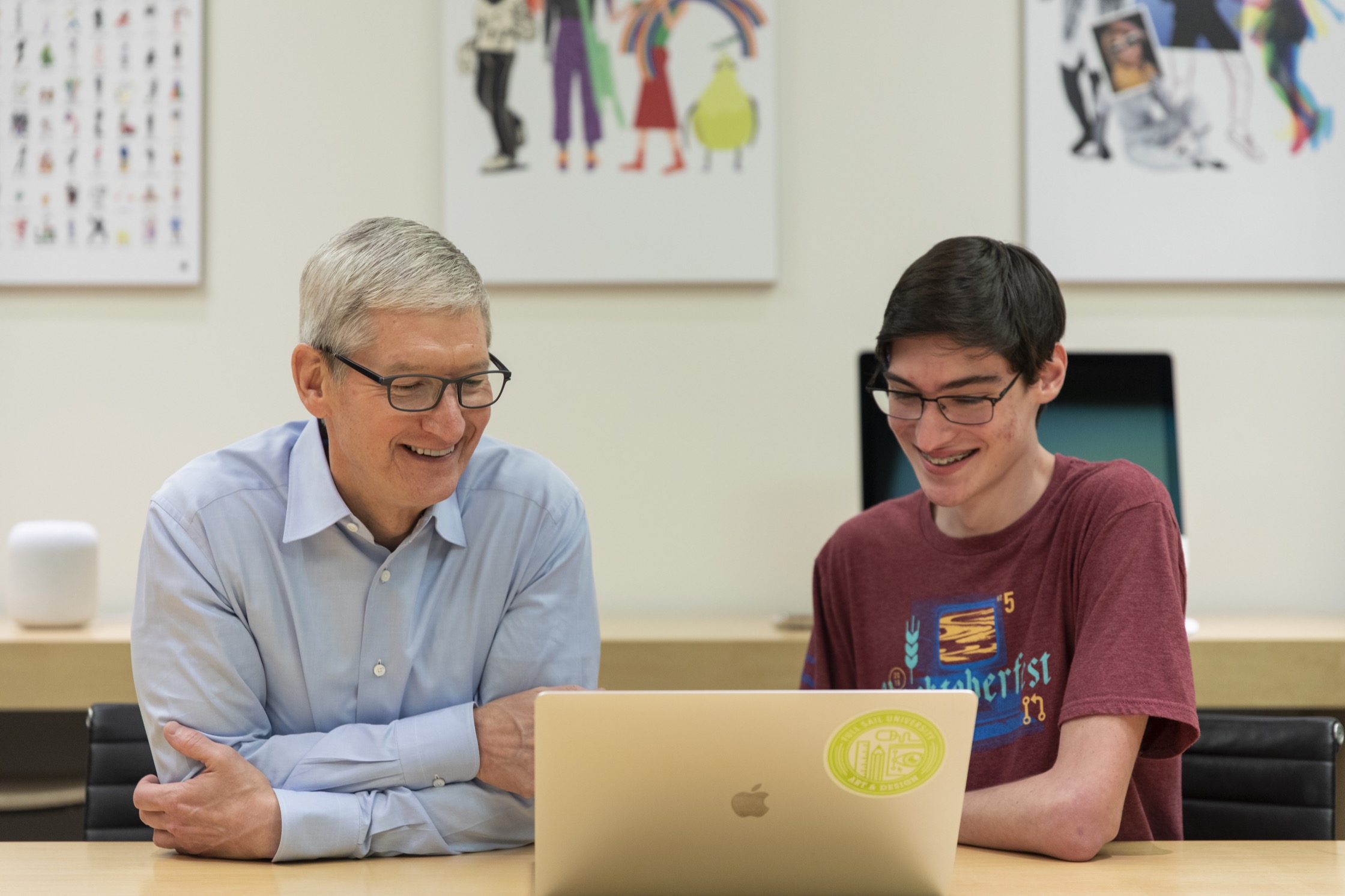
Pathways to coding
I’m curious about the way that Liam’s classmates perceive coding and computer science. I know that, even at my fairly computer-focused high school over 20 years ago, it was very rare to see anyone not in the class understand or care about what we were up to.
“The vast majority are impressed but they don’t get it — but what I was interested in is getting people who have any interest at all and wanted to pursue it and then giving them the tools and the community that’s necessary. It’s worth it, just to see the community we created [with the club.] I’m very proud of how that’s come in like, three quarters. Next year we’ll exist from [the beginning.] Hopefully, our membership will grow a lot that time. And just, I am really, I’m hopeful of what we’ll do in the future.”
Liam’s teacher and sponsor, Mary Acken, was a software engineer who had working experience in several technology companies and had grown up in the area. She quit her job and started teaching computer science when the previous CS teacher passed away and the school needed someone to carry on the curriculum. She’s become a local advocate for the programs at the school and started a local Girls Who Code chapter.
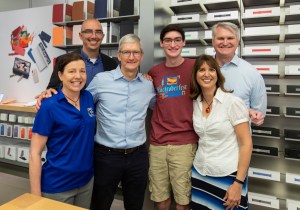
Tim Cook and Liam are joined by his parents, his teacher Mary Acken and the principle of Lyman High.
“Eight years ago, when I first started teaching, and I threw out some assembly language, they thought it was a foreign language, and they froze,” says Acken. “And now…because Seminole County Public School starts at such a young age, we have some coming from middle school and they have a little bit of experience. A little bit of exposure, and that exposure can help them to feel more comfortable with it.”
Liam’s path to code started with a Khan Academy course. JavaScript, to be specific. He said he learned the basics there just before 7th grade. When he got to his middle school, he realized there was a Python course and started chipping away at that. By the time he got to his freshman year in high school, he started having a desire to make an app for this thing everyone carried: the iPhone.
“So I just started messing around, maybe made a couple of filler apps — and I just really love Swift. It’s a beautiful language. Like it’s, it’s opinionated enough that there’s a direct way to solve something, but not too opinionated,” he says.
Though my time with him is short, it’s easy to tell how entranced Liam is by the act of creating through programming by the way that he immediately springs open Xcode and walks me through his app’s package to show me where he integrated custom graphics, open-source resources and his own code. But, if that wasn’t enough for you, he also exhibits the most telltale sign of a true programmer. When I ask him if he enjoys playing with Swift Playgrounds, he says he has mixed feelings.
“I have mixed feelings towards working with Playgrounds, because there’s this little tiny bug in Xcode, where if your module doesn’t compile right, it pops up an error and you have to dismiss the error to keep typing. Yeah, but other than that, it’s great!”
A developer complaining about buggy tools? Yeah, he’s legit.
But that conversation with Liam does bring up some questions, and I ask Cook whether he thinks there are more viable pathways to coding, especially for people with non-standard education or backgrounds.
“I don’t think a four-year degree is necessary to be proficient at coding,” says Cook. “I think that’s an old, traditional view. What we found out is that if we can get coding in the early grades and have a progression of difficulty over the tenure of somebody’s high school years, by the time you graduate kids like Liam, as an example of this, they’re already writing apps that could be put on the App Store.
“That’s pretty cool, if you think about it. He’s just a sophomore in school. From there, you can go the community college route and get more in-depth. You can go dabble in a traditional university. You can do some things on your own, if you’re self-motivated, or go to work for someone that you have to program for.”
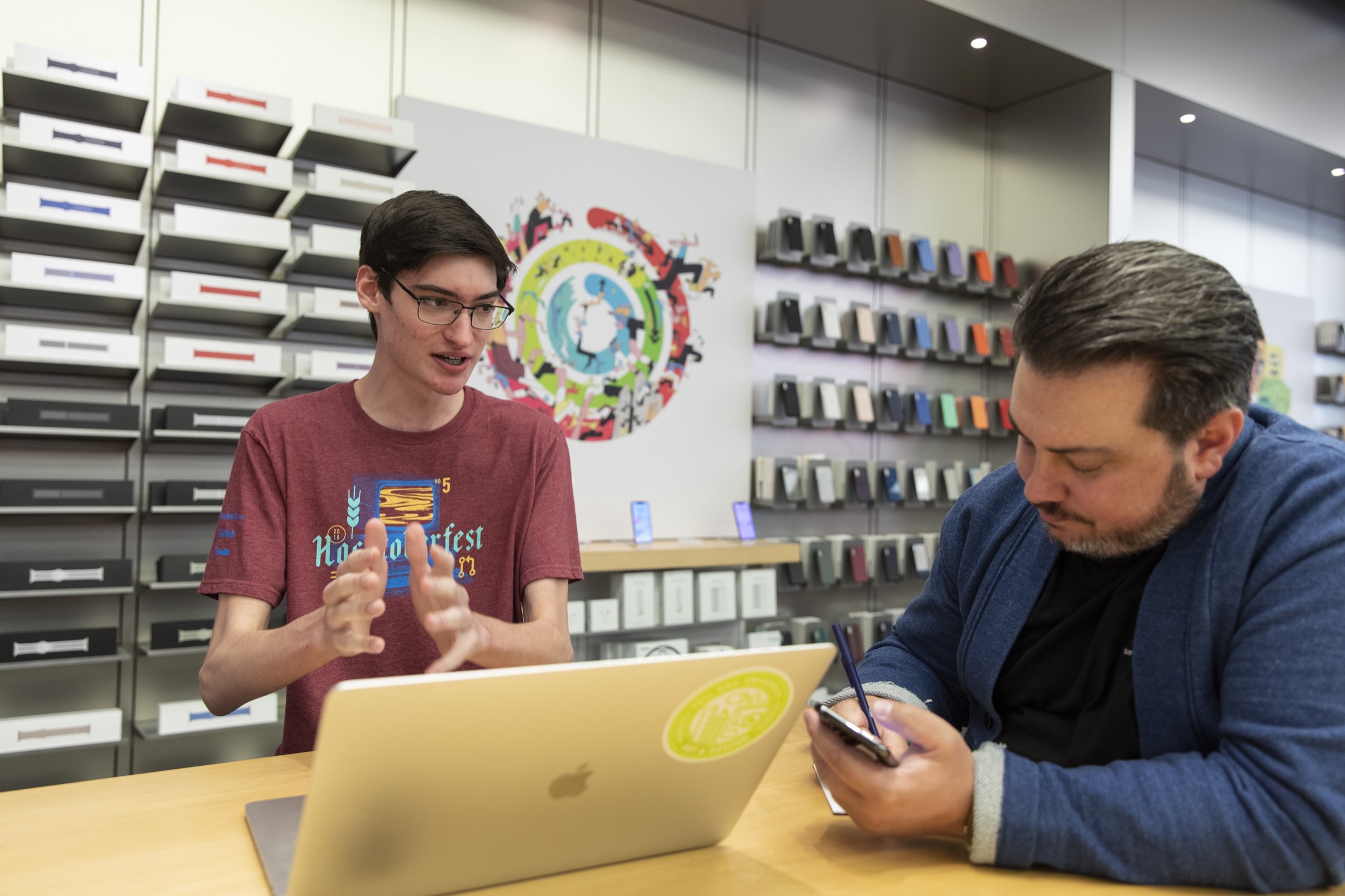
Cook points out that, aside from big tech companies, most businesses don’t have anyone on staff that can program anything, but every business is touched somehow by software. Though the consumer landscape has been affected massively by huge end points like the App Store, enterprise businesses have been slower to adapt, he notes.
“Lots of the interfaces, whether you’re in a small business, or a medium business, or, frankly, some large businesses that are still using very old technology and ways of doing it.
“I think what it is is they haven’t embraced mobility. They haven’t embraced machine learning. They haven’t embraced AR. All of this stuff is a bit foreign in some way. They’re still fixing employees to a desk. That’s not the modern workplace,” Cook says. “People that graduate from high school and get a little experience under their belt can do quite well in this job.”
If you look at Liam at his core, I talked with him just a bit, but it’s clear his number one trait is curiosity. That is, from what I have seen over many, many years, one of the successful traits of almost every single person I’ve met that’s highly successful. You want to learn. You’re curious. How does that work? You go and you work on that. Then, all of a sudden, that opens up another couple of doors. You go down a door. All of a sudden, you’ve got a bunch of doors. You just learned a lot of stuff that maybe you weren’t even trying to do.”
Coding humanely
Cook and I have a few more minutes to talk, so I keep this thread going. If you’re going to emphasize the intersection of coding and the arts as an ideal, you can’t divorce that idea from a concept that more and more discussions are being had about lately: coding humanely. Tech companies have gotten very, very good at building very efficient products, but products that aren’t as aware of the humans that are using, or mis-using them as they need to be.
They’re just not aware of either personal rights or rights as a society — either privacy or other rights. It seems like, with coding programs and training especially, people get hyper-focused on the skills learning and not so much on the centering of coding inside a shell of humane learning.
If you, say, bring music and art and coding together, you end up with a more durable, perhaps even more aware, product than if you were just good at coding.
“I agree. One of the big things that encourages me so much about the younger generation is they care deeply. They see their role in society much broader than my generation did,” Cook says. “That gives me a lot of hope.”
I bring up a dumb, but somehow poignant TikTok video I saw the other day. In it, a kid expresses his annoyance at trying to avoid all of the various surveillance tools his parents use to track his whereabouts and, ostensibly, keep him safe.
“Surveillance existed in another way when I was a kid,” Cook notes. “Occasionally you’d read about some bizarre character out looking in people’s windows. That was a form of surveillance. The fact is, that person has such a limited view of your life, they’re viewing in one window, of one room, in one hall. Now, unfortunately, it’s that on steroids.
“I think we have to go back and remind ourselves that privacy is one of those special things that make us uniquely American. It’s a core civil liberty and it didn’t just start being one. It’s the foundation for a lot of other civil liberties that are so important to us. The freedom of expression, the freedom of the press, the freedom of speech. You just go on, and on, and on.
“If that one crumbles or cracks in a significant way, it’s not only that one that is cracking, it’s all of these others that are falling down apart, as well.”
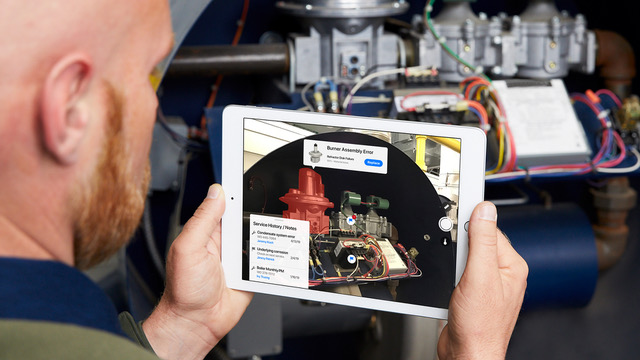
Apple and SAP
We move on to another leg of the coding and tools education discussion: the enterprise. Cook is fresh off of the SAP Sapphire conference, where Apple and SAP announced a few pretty solid expansions to its integrations with one of the most popular enterprise data processing suites in the world.
SAP is adding Core ML to its Cloud Platform SDK for iOS, which will allow SAP applications to run data modeling on-device, allowing for more flexible and responsive ML applications that don’t rely on cloud data sources or transmission to be effective. It’s building new native apps for iOS starting with Ariba and it’s building its apps for the Mac.
It’s a tock of the strategy Apple began pursuing with large enterprise carrier hosts like IBM and SAP a few years ago, positioning its tools and frameworks as services to be implemented by the enterprise much in the way that Apple’s hardware worked its way into the enterprise through the side door of ease of use.
While Apple has long worked to educate and develop teachers on the ostensible benefits of its ecosystem for education, the work it has been doing in the enterprise has entered a big new phase recently. It’s tailoring its offerings to these customers in ways that it previously had not delved into. In mobile, especially, Apple has a toehold here to work with.
“I think that you would find that most CIOs over here would tell you that it’s their — maybe their only — but at least their preferred mobile operating system for enterprise for a whole variety of reasons. Privacy, security,” Cook says.
I point out that the trickle-down effect of the device that the CEO loved and thought was easy to use was what started the bring-your-own-device era, kicking open a door for Apple into the enterprise.
“You’re right, the trend that started it was the forward-leaning CIOs who said the employee decides,” says Cook. “The employee has the right to decide what device they want to bring in. ‘We’re now going to convert to a service model ourselves and find a way that they fit.’ ”
Cook says that Apple saw that shift toward the employee-first hardware rollout as it was happening. They saw the iPhone drive a wedge in, the iPad expand it with retail, sales force and training applications and the Mac, of course, as a development platform for iOS got pulled along on the swell.
He likens what Apple is trying to do in enterprise with what it did for consumer businesses in 2008 with the App Store. The “explosion of apps” and use cases for iOS hardware that were presented to the consumer. Despite all of that, Cook says, you won’t find most small, medium or even large businesses changed by that revolution.
“If you went inside [most] businesses you wouldn’t find that they had changed a whole lot. They’ve changed some, but they haven’t fundamentally transformed their business with the huge capabilities that are now there,” Cook says. “This is about getting there. This is about changing the way people work and making their jobs better, making them more productive. I think that we’re at the beginning of a very long arc here in terms of the fundamental re-plumbing and changing of business processes in our products. It’s huge. Not just enterprise. It’s also medium business and small business.”
Apple is currently mid-stride in this effort to form a third leg of services businesses to even out the imbalance from the rapidly maturing smartphone market. Deals like this one with SAP are key because they allow Apple to become part of the plumbing of the enterprise workflow, not just the shiny taps used to access it.
Apple’s efforts to make sure that it remains welcoming to young technologists looking to address an enormous market with their fledgling products and companies and this new service-oriented strategy are linked at the hip. If it is able to keep its reputation for being the most commercially viable outlet available for consumer-facing products and also keep those products on board while they scale through small and medium stages and into enterprise-scale offerings, it will help immensely in its efforts to thrive in a hardware saturated world.
